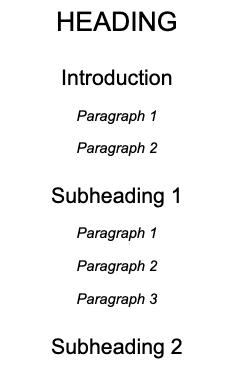
How to Structure a Blog Post (a Step-By-Step Guide)
Blog posts are many freelance writers’ bread and butter. This means that knowing how to produce the best blog content, from planning to publishing, is an essential skill.
In this post we’ll cover the basics of planning and why it’s essential to structure your blog posts, before delving into the four key parts of a blog post’s structure:
- The title
- The introduction
- The body content
- The conclusion
We then finish up with three examples of well-structured blog posts.
Why Do You Need to Structure Your Blog Posts?
A carefully chosen blog post structure can:
- Provide a clear base to build on, which can make writing your post quicker and easier
- Improve readability, which in turn will boost search engine optimization (SEO) and help your post appear higher up in Google search results
- Demonstrate your skill in crafting high-quality content, drawing the attention of both readers and potential clients and building your brand credibility
By structuring your blog posts, you increase your chances of engaging with and maintaining your audience.
So whether you’re writing a blog post for your own blog, producing blog content for a client, or contributing a guest post, structuring your blog posts is a crucial part of the writing process.
Planning Your Blog Post
Now we know why structuring your blog posts is so important. But before you begin working on that structure, you’ll need to put a plan together.
Depending on the context and complexity of your post, planning might include:
- Identifying your target audience
- Conducting keyword research
- Considering the key topics and subtopics within your subject matter
- Gathering the information you intend to write about
If you’re writing a blog post according to a brief, many of these points may already have been covered. However, it’s still important to take some time to collect all the relevant information.
How to Structure a Blog Post (in 4 Steps)
Whatever your blog post is about, there are four key building blocks that all posts should be founded on.
These blocks are:
- The title, which introduces the subject of the post
- The introduction, which explores what the post will cover in more detail
- The body, which covers the main topics and subtopics of the post
- The conclusion, which ties up the ideas explored in the post
In the next few sections, we’ll take a look at these elements in detail.
1. The Title
A blog post’s title or heading might not seem like much compared to the rest of its content, but it’s this part of the structure that readers will see first.
This means it’s important to create a title that is compelling, informative, and relevant to the content of the blog post.
Depending on your post’s content, the title could contain a number (e.g., “10 Reasons Why You Should Own a Poodle”), begin with the phrase How to (e.g., “How to Fix Your Dishwasher With No Plumbing Knowledge”), or pose a question (e.g., “What Is the Speed of Light?”).
For more tips on choosing a title for your blog posts, check out Wix’s guide.
2. The Introduction
The introduction is where you can convince readers that the rest of your post will answer their questions and is worth reading further.
Your introduction should:
- Set out the main topics you intend to address
- Explain why the post is relevant to your audience
- Establish your expertise with a figure or statistic, anecdote, or summary of your experience with the subject matter
- Be concise and easy to read
You might also want to include a table of contents that shows exactly what your post covers, and make sure to use any keywords you identified in the planning stage.
3. The Body
The body of your blog post is where the bulk of your content is found.
To prevent it from getting too long or difficult to navigate, you can split the body into separate sections organized under headings and subheadings, then further into paragraphs:

You can start with the most relevant information in the first paragraph, then go into further detail with each subsequent paragraph.
This also allows your audience to skim read your post and pick out the sections most relevant to them.
The order in which you structure your sections will be more obvious for some posts than others. A how-to style post, for example, should present each step in chronological order.
But however complicated your subject, each of your sections and subsections should lead smoothly into each other and be arranged logically.
To help smooth the progress from one section or paragraph to the next, make use of transition words such as also, because, so, and finally.
4. The Conclusion
In your conclusion, you should tie everything you’ve covered in your post together.
The conclusion is also the perfect place to add a call to action that prompts your readers to take the next step, whether that’s signing up for a newsletter or buying a product.
You could also use the conclusion to direct readers to other relevant blog posts and keep them engaging with your content.
Blog Post Examples
Now it’s time to see how blog post structure works in practice.
Below are three blog posts from well-known blogs that demonstrate the structure we’ve outlined here.
1. Say Yes: How to Wrap a Bouquet of Fresh Flowers (And A Secret Freshness Trick!)
In this post, lifestyle, parenting, and craft blog Say Yes provides a how-to guide to presenting fresh flowers.
The post’s title clearly establishes the purpose of the post, while adding the extra hook of a secret trick.
The post itself introduces its subject and the guest expert, then breaks down into the following sections:
- What flowers to buy at the grocery store?
- How to take care of fresh cut flowers?
- How to wrap a bouquet of fresh flowers:
> Step 1: What do you wrap flowers in?
> Step 2
> Step 3
> Step 4
> Step 5 - What flowers stay freshest the longest?
The post concludes with links to other bouquet and craft-related blog posts.
2. Bright Bazaar: My Top Three Fall Road Trips
Bright Bazaar is an interior design, style, and travel blog run by designer Will Taylor. His post shares his favorite fall road trips, starting with an introduction to the season and the post’s sponsor.
The post is then split into three sections:
- Ski Resorts
- Coastal towns
- State Parks
While this post doesn’t have a clear conclusion, it does end with a call to action in the form of directing readers to the sponsor’s website.
3. Treehugger: Your House is Killing Birds, Here’s What to Do
Our final example comes from Treehugger, a blog dedicated to green living and environmental causes.
The title of this blog post immediately draws attention with its emotional heading, while promising a solution. Following an introduction including statistics and a table of contents, the post covers a series of sections:
- High-Rises Versus Low-Rises and Houses
- Why Do Bird-Window Collisions Matter?
- The Problems With Birds and Glass
- If You Have Bird Feeders or Native Plants
- Make Your Windows Bird-Friendly
- What Doesn’t Work to Prevent Bird Collisions
- Dim Your Exterior and Interior Lights
- Keep Cats Indoors
- If You Find a Stunned or Injured Bird
The post then ends with further reading on how to care for injured birds and prevent further issues.
Becoming A Freelance Writer
If you fancy a career writing blog posts and other content, our Becoming A Freelance Writer course could be your ticket to your dream job.
See what we can help you achieve by signing up to sample two free lessons from the full course!





Your email address will not be published.